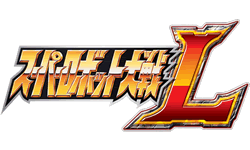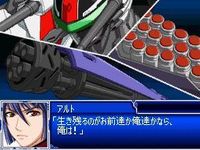|
|

|
PLATFORM
|
DS
|
BATTLE SYSTEM
|

|
INTERACTION
|

|
ORIGINALITY
|

|
STORY
|

|
MUSIC & SOUND
|

|
VISUALS
|

|
CHALLENGE
|
Hard
|
COMPLETION TIME
|
20-40 Hours
|
|
OVERALL

|
+ Smooth & colourful animation
+ Pairing up units simple and effective
+ Excellent original music
- Convuluted storyline
- Some sprite reuse from other SRT games
|
Click here for scoring definitions
|
|
|
Super Robot Taisen L is the 3rd SRT game on the DS, and the next game added to the ever growing list of Super Robot Taisen games that will never be localized. While seeing Mazinkaizer fight alongside EVA Unit 01 and Strike Freedom Gundam might appeal to the tactical RPG and/or average giant robot fan, the myriad of licensing issues will sadly prevent this and almost every other SRT game from reaching foreign shores. However, it is not all hopeless. The Nintendo DS remains a region-free handheld console, so the intrepid importer might find a surprising amount of fun buried within the massive Japanese-filled text dumps.
Unlike the Original Generations series localized by Atlus, the worlds of the main Super Robot Taisen games are mashups of the various series included within them. No exception to this rule, L's story is told through the eyes of an original character, who must contend with a smorgasbord of villains and some mysterious rivals lurking in every corner. The main character this time around is Ichitaka Nagumo, a high-school student who is already friends with several members of the Linebarrels of Iron cast. Following a rapid sequence of events, Ichitaka finds himself in the pilot seat of a brightly coloured mecha named Rushbird, his house has been trashed, his father/mad scientist has been kidnapped and his older brother has run off in pursuit. In addition, more bad guys are attacking his home town, and he has a robotic housemaid named AL-3 Alice as a support pilot. Confused yet?
This is a sort of double-edged sword for the game's storyline. There are two prologue stages, but these are designed to introduce the player to a couple of the included series and their place in the plot rather than serve as any sort of gameplay tutorial. The rapid introduction of series and their addition to the growing squad of units is a benefit to the player who wants less time commanding small selections of mecha and more time stomping across the battlefield, but might overwhelm the first time player by sheer quantity of metal stompy things and the mechanics required to control them effectively. As might be expected, non-fans of robots probably won't enjoy this game, and chances are high that not having seen any of the included series will make one feel lost.
Like most other SRT games, the game is laid out in a linear fashion. Clearing a stage will result in some expository text, followed by an intermission screen that paves the way for the next battle. There are a series of route splits where the team will divide for a few stages before rejoining. These are made extremely clear, and the player is provided with a warning over what portion of their forces will be going to the next stage. The stages themselves are designed to follow certain events or episodes of the included series, but will often feature unexpected surprises from other factions that alter how those events originally progressed. After deploying a subset of your forces to the battlefield, combat proceeds in alternating phases between the player, the enemy and any neutral factions in a fashion similar to Fire Emblem.
 Contains 250% of your recommended daily intake of missiles
Contains 250% of your recommended daily intake of missiles
|
|
Each unit is equipped with a set of weapons that mimic those that it possesses during the source series, each with varying attack power and range. These drain either the unit's overall energy supply (EN) or have limited ammo. Pilots have an individual morale statistic, which rises as they attack enemies and evade attacks or take damage. High morale unlocks the more powerful weapons on a unit. Each pilot also has a set of six 'spirit commands' that are learned by levelling and are similar to one-shot magic spells; careful usage of these is the key to defeating tougher opponents, as each pilot only has a limited supply of hard-to-refill spirit points (SP). This formula has been present in practically every SRT game for what seems like forever, and it's good to know that Namco Bandai isn't trying to 'fix' something that isn't broken.
Shooting down opponents grants money, which is used to upgrade mecha, and skill parts, which are one-use items that provide new pilot abilities and raise pilot stats. A few examples of what pilots may learn are: abilities to reduce SP costs, defend allies more often in battle, and increase damage with melee or ranged attacks. It should be noted that due to the linear progression of the game and the inability to return to stages already cleared, it is quite difficult to 'grind' upgrade money. This means that upgrade money and skill parts must be carefully distributed amongst the large list of mecha. Like the storyline and the mechanics, this might seem exceptionally daunting to the first time player. To an average SRT fan, this is almost second nature.
Rather than sending out single units, SRT L uses a system similar to the Twin Battle System previously seen in Super Robot Taisen Original Generations, and more advanced than the one implemented in the previous DS title Super Robot Taisen K. During intermissions, each unit can be paired with another one, which grants both units a set of bonuses, and allows them to support one another in combat. Paired units are more effective in combat against enemies in pairs, and since most enemy units will attack that way — with the important exception of bosses — this is a system that players will want to use. Plus, it means more units on the battlefield, which means more experience for the pilots, and more bad guys turned into wispy piles of scrap metal. Since pairs can be switched while stages are in progress at the cost of the unit's turn, this system is far more flexible than the one seen in SRT K, and the gameplay is better off as a result.
On the map screen, units are represented by simple depictions of the mecha's head. The meat of the graphical work in SRT L, like in other games in the SRT series, comes when the attacks start flying around. Units are animated via 2D super-deformed sprites, and even though some units have reused sprites from previous SRT games on the Nintendo DS, care has been taken to enhance them a bit with new cut-in art or animation. The presentation is smooth, and great care has been taken to ensure that battle animations are very accurate to their source material. The only unfortunate change made to the animations in SRT L is that most boss characters are immune to dynamic kills, where an extended attack takes place if a powerful strike is used to fully deplete a unit's HP. This is not exactly a major change, but may bother some SRT veterans. For those who get tired of seeing the animations, they can be sped up, or simply switched off. In the latter case, a short summary will be shown of how much damage was inflicted and if any damage was blocked or evaded — perfect for the commander in a hurry.
 This is probably going to hurt. A lot.
This is probably going to hurt. A lot.
|
|
While some players may miss the lyrics from their favourite opening themes, they function well as background music, and anything deemed annoying can be simply switched for another track, making it possible to have the Evangelion units battle to the tune of JAM Project's FIRE WARS. There are a few occasions where the BGM will be overridden, usually involving Macross Frontier and idol concerts, so any non-fans of Sheryl Nome's finest work will have to sit and bear it for a little bit. The original themes composed for SRT L fit the characters they are given to very well, with Ichitaka's matching his upbeat and lively personality, while his aloof older brother has a more muted theme to reflect his lone wolf-ish nature. Regardless of its origin, the music in the game is always welcome and never less than superb.
Super Robot Taisen L has a respectable fourty-three stages, with several route splits. Since the stages will take a little while to go through, even with the animations off, there is at least thirty hours of gameplay to chew through. Those enterprising souls who wish to see everything SRT L has to offer will have to partake in a New Game+ once the story is completed.
The level of Japanese required for those interested in importing could be best described as 'moderate'. While the story is buried in reams of Japanese text, those who have already seen some of the series included may already have a handle on what's transpiring, and although full comprehension may be quite difficult for everyone outside the most dedicated language scholars, inference of events with a little outside knowledge and some basic kanji is quite possible. This reviewer would recommend that any prospective player of import SRT games examine a cheat sheet of basic game mechanics, as well as the spirit commands and upgrade mechanics. Since each SRT game uses a similar system, this will be of use in more than one game.
To an SRT fan, this game is a significant improvement over SRT K, the gameplay elements are stronger, the included series work better together, and the music is fresh and original. However, to a tactical RPG fan who is not familiar with the series as a whole or particularly au fait with giant mecha, then SRT L might seem like a confusing typhoon of explosions and bits of scrap metal. It looks really nicely animated, but it's still confusing. For a fan of giant mecha, this is a strong import choice, and any fan of the SRT series should look into adding this to their play lists, and this also holds true for any fan who has been interested in the unreleased side of SRT. Other tactical RPG importers might have some fun here too, but would need to beware the prevalence of mecha clichés.
Review Archives
|









